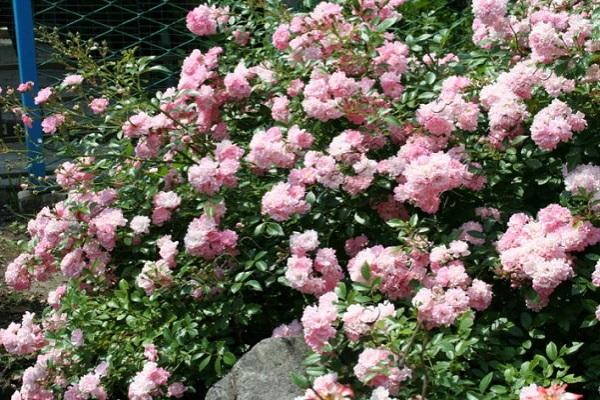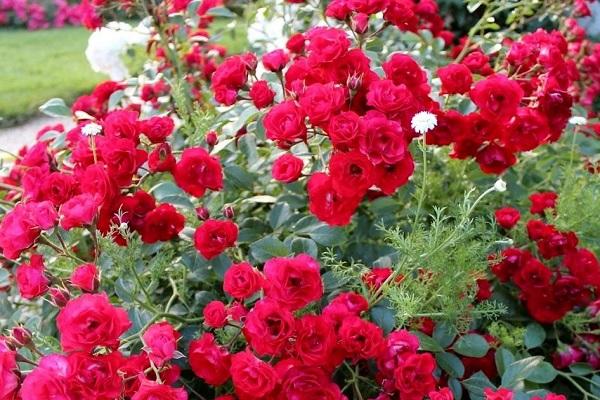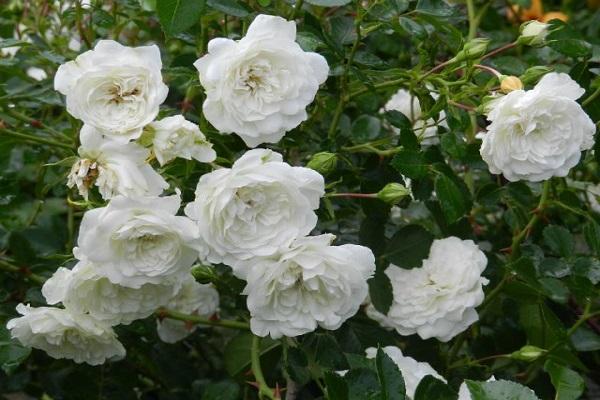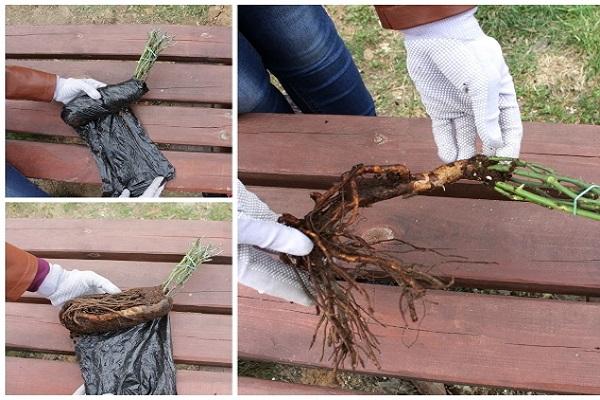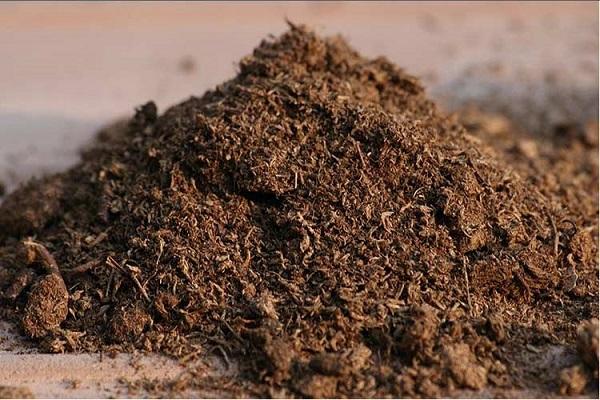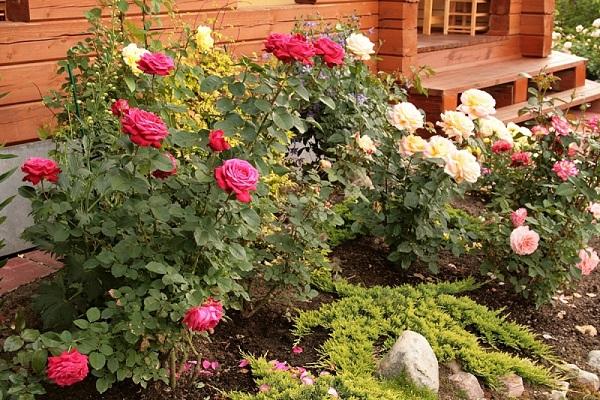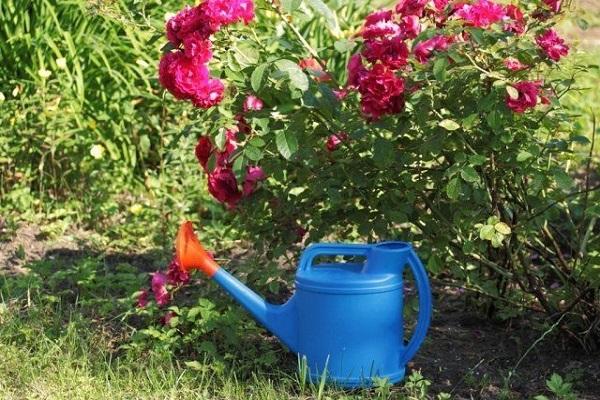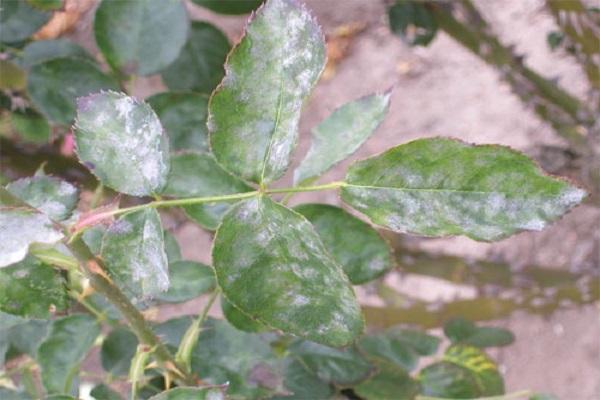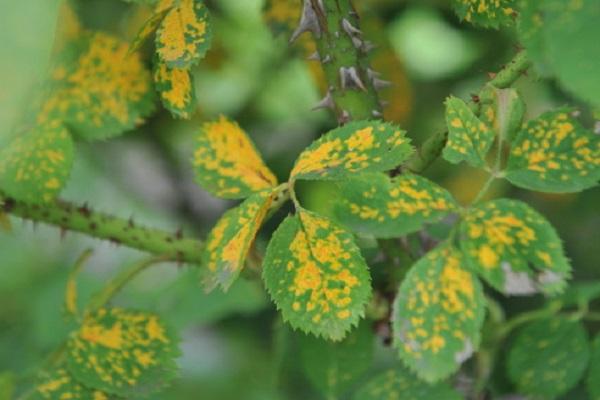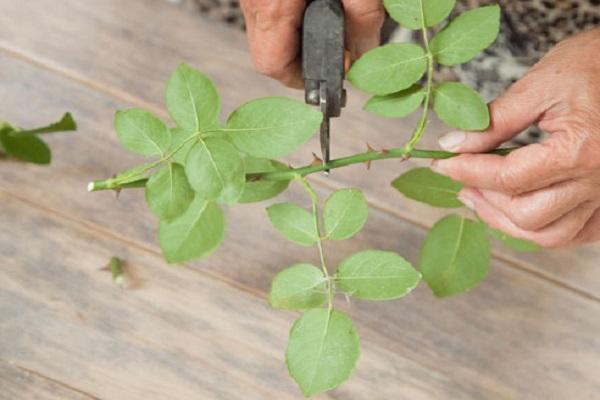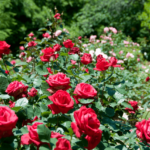Groundcover roses are groups of plants with long stems that cascade down or trail along the ground to form a living carpet. During the flowering phase, the bush is covered with clusters of lush white, pink or red flowers. Species differ from each other in plant size, flower structure, direction of shoots and resistance to unfavorable conditions. What other features do ground cover roses have, and how to grow an elegant flower?
- General information about ground cover roses
- Flower varieties
- Winter-hardy
- Resistance to known diseases
- Most beautiful
- Features of planting plants in the garden
- Choosing the optimal landing site
- Preparatory activities before the landing
- How to properly plant ground cover roses in the garden
- Care instructions
- Irrigation scheme and rules
- Features of feeding
- Pruning roses
- Shelter for the winter
- Diseases and pests
- Propagation methods for ground cover types of roses
- The use of varieties in landscape design
General information about ground cover roses
Ground cover roses are a relatively young group of plants: they were bred only at the end of the 20th century, based on the Vikhura rosehip and the Wrinkled rosehip. The first specimens bloomed only once a year, with white, pink or red flowers..
Depending on the chosen variety, ground cover roses can be low - with horizontal shoots, or high (up to 1.5), the branches of which fall down. Thanks to the work of breeders, today ground cover roses bloom until frost, and their shape, size and color never cease to amaze with their diversity.
Flower varieties
The group called “ground cover” includes dozens of species. Therefore, when choosing a flower, you need to compare the characteristics of the species you like with the conditions of the region.
Winter-hardy
One of the brightest representatives is the Fairy variety. Compact bush with falling shoots. Plant height is 60-80 centimeters. The leaves are dark green, small, with a glossy surface. The variety is not afraid of cold, disease and shading. A winter-hardy species called Hello. Bush 30-50 centimeters high. Double flowers with a diameter of 5-6 centimeters, consist of 110-120 petals. At the beginning of flowering, the color is dark cherry.
Resistance to known diseases
Scarlett is a tall bush with double flowers with a diameter of 3-4 centimeters, painted cherry-red. Height ranges from 1 to 1.5 meters. The rose is highly resistant to diseases and tolerates winters well.
Plants of the Fair Play variety are large, spreading: diameter – 2, height – 1 meter. The flowers are pink, semi-double. There are up to 50 of them in one inflorescence.The bush is used to decorate slopes and borders.
Most beautiful
The Swaney variety surprises even sophisticated gardeners with its beauty. A spreading bush, densely strewn with double white flower rosettes with a pink dot in the center. There are 5-20 flowers in one branch. Plant width – 1.5 meters, height – 0.6-0.7. The species has high immunity to powdery mildew.
Ballerina is the species recognized as the most beautiful at the rose growing competition in 2001. Plant height is 70-90 centimeters, width – 120. The flowers are 4-5 centimeters in diameter, pink, with a white dot in the center. The brush consists of 40-50 flowers.
Features of planting plants in the garden
The well-being of the plant depends on how the planting was done. If a flower doesn't like where it's placed, it won't bloom.
Choosing the optimal landing site
It is best to plant graceful ground cover roses on slight natural slopes to the southeast or west. This way the plants will be well lit in the morning, and slightly shaded at noon, which will prevent the flowers from withering and discoloring.
In the shade, roses grow slowly and bloom poorly, so the place for flowers should be away from large trees and structures. It is best if the site has well-drained soil.
Important! Due to the presence of groundwater, the plant gets sick, and in winter it becomes hypothermic and dies.
The optimal growth environment is loamy soils that allow water and air to pass through well. To improve clay soil, add sand, peat, and organic matter. You can plant a flower in sandy areas only after adding turf, peat, compost and clay.
Preparatory activities before the landing
Before, how to plant a rose in open ground, you need to prepare the soil mixture. To do this, mix garden and turf soil, peat, and rotted manure in a 1:1 ratio. Depending on the type of soil, sand or clay is added. Add 100 grams of wood ash and superphosphate to the substrate.
2-3 weeks before planting, dig a hole and place a 10-centimeter layer of bird droppings on the bottom. A hill-shaped mound is made in the center of the recess.
How to properly plant ground cover roses in the garden
Planting is one of the most important processes in growing plants. Before planting, the upper and lower parts of the plant are shortened to a length of 25-30 centimeters, and then sprayed with a solution of copper sulfate.
The seedling is placed on the top of the mound, and then the roots are straightened to the side, the missing soil is added, and it is compacted. 10 liters of warm water are brought under the bush and the surface of the hole is covered with a 10-15 cm layer of earth. To protect the seedling from scorching rays, a screen is installed on the sunny side.
Care instructions
In order for flowering to be as abundant as possible, the plant requires certain conditions. Caring for a bush consists of such manipulations.
Irrigation scheme and rules
Roses are watered early in the morning, when the sun has not yet had time to brightly illuminate the bushes. You cannot add water in the middle of the day: the sun will burn the areas of the leaves on which water remains.
Flowers like to grow in slightly moist soil: overwatering, as well as underwatering, is dangerous for the plant. Good watering is carried out after the soil has dried 3-4 centimeters deep. In autumn, the amount of watering is gradually reduced.
Features of feeding
The abundance and duration of flowering depends on how rich the soil is.Ground cover roses are fertilized according to the following scheme:
- Two weeks after the leaves appear on the bush, complex fertilizers are applied, which contain nitrogen, phosphorus and potassium.
- In June, when budding begins, the plants are fed with calcium nitrate and organic matter. Before flowering, plants are watered with a solution of potassium and magnesium sulfate. Consumption per adult bush – 2 liters.
- Faded roses are fertilized with a mixture of phosphorus and potassium and manure. The leaves are sprayed with a solution of ash and mineral fertilizers.
- At the beginning of autumn, the bushes are pampered with potassium magnesia.
Pruning roses
Creeping roses, like other bushes, need shaping and rejuvenation. Garden manipulations are carried out according to the following plan:
- Trim dry, damaged and diseased branches to live wood.
- Remove shoots whose growth is directed towards the center of the bush.
- Old, 3-4 year old branches are cut off, and young shoots are shortened, counting 7-10 buds from the base.
Anti-aging pruning is carried out once every 5 years, shortening the shoots to 10-15 centimeters. Ground cover roses are not pruned for the winter.
According to another opinion, ground cover roses do not need shaping at all, as they look great without any intervention.
Shelter for the winter
Ground cover roses are not afraid of frost and winter well under a layer of snow. In regions with little snowy winters, bushes are insulated. Tall species are first carefully bent down and then covered with pine spruce branches.
Important! Preparations for wintering are carried out when it gets cold outside.
Diseases and pests
Growing ornamental plants is not complete without treatments. Rose varieties with low resistance to harmful bacteria are susceptible to a number of diseases.Plants with high immunity growing in dense plantings can also get sick.
- Powdery mildew. The leaves become covered with a whitish coating, and soon curl and fall off. To combat the disease, the bushes are sprayed with a 2-3% solution of Bordeaux mixture or a 30% solution of ferrous sulfate.
- Black spot. Due to excess moisture or lack of potassium, the leaves turn yellow and become covered with dark spots. Diseased leaves are torn off, and the plant is treated with 1% Bordeaux mixture or copper-soap solution.
- Gray rot. Young leaves and shoots are covered with a fluffy gray coating. The buds rot and ulcers form on the petals. During prolonged rains, manganese is added, and the diseased parts of the plant are torn off.
- Rust. Fungal disease; manifests itself as red bumps and dusty pustules. The leaves turn yellow and crumble, and immature shoots become deformed. Treatment is carried out with a 2% solution of Bordeaux mixture and nettle decoction.
From the order of insects, bushes are damaged by spider mites, green aphids, roseate scale insects and leaf rollers, and the slobbering frog. To control pests, roses are sprayed with insecticides and decoctions of garlic and tobacco..
Propagation methods for ground cover types of roses
The creeping flower is propagated by seeds, budding, layering and cuttings. The first method is used mainly by specialists, since in this case maternal characteristics are not inherited. Only experienced gardeners can successfully carry out budding.
Amateur flower growers propagate roses by layering. To do this, the shoot at the knee is sprinkled with earth and secured with a pin. Plants are separated in the summer or autumn of next year.
At the end of summer, cuttings with three internodes are cut from healthy mature shoots. The cut is made under the bud in the middle of the shoot.Cuttings without thorns and leaves are kept in a growth stimulator for 2 hours. In a semi-shaded area of the garden, make a ditch 15 centimeters deep and fill it a third with sand.
Planting material is installed at a distance of 15 centimeters from each other so that the lower bud is above ground level. The cuttings are regularly watered, and the resulting buds are torn off. The rose is ready for planting in a new place next fall.
The use of varieties in landscape design
Ground cover roses look equally excellent both in single and group plantings. Flowers are planted along a path, pond or in the center of the garden, thereby separating one part from another. Creeping roses are ideal for growing in multi-level beds.
Thanks to their decorative value and variety of varieties, creeping roses are gaining more and more popularity every year. Since the flower does not require special care, even a novice amateur can grow it in his own garden.

